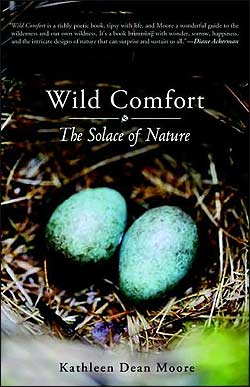
Grief and the Changing World
Kathleen Dean Moore names and explores nature and pain
by Molly Templeton
 |
OSU professor Kathleen Dean Moore’s new book, Wild Comfort: The Solace of Nature (Trumpeter Books, $15.95), isn’t the kind of book you can read just anywhere, at any time. Oh, you can read it anywhere, but it’s not best served by, say, sitting uncomfortably on a train, with all that mechanical noise and the sounds of strangers pressing on your ears. The book takes place in warm homes and cold clearings, in small boats and in the rain. It wants to be read in quiet, in a place where the way the air shifts with the seasons is clear on your skin, when the sky changing colors gives you something to look at when Moore is contemplating glowing sea life or a community tightening in the wake of a storm.
Moore is so engrossed, so efficiently absorbed by what she writes about, that the entry point for the rest of us can seem hidden. Why is this woman getting up in the morning to look under snake tins — pieces of corrugated metal scattered over a field in the places snakes might like to sleep — and why would she want snake tins in the first place? It takes a few chapters to figure that out.
Wild Comfort is not a general book about sense of place, though it has that elusive and specific quality in spades. The introduction, which gives much-needed perspective, is unusually important: Moore meant to write a book about happiness, but, she writes, “events overtook me.” A series of deaths changed the course of her work. With Wild Comfort, she writes, she is trying to understand “the power of water, air, earth, and time to bring gladness gradually from grief and to restore meaning to lives that seem empty or unmoored.”
That won’t work for everyone, but it works for Moore, who writes of rain, plum-eating possums, broken pots, birds, crabs and snow with a steady calm that seeps through her pages, replacing the lingering, thick fog of grief. It’s not a broad solace the subtitle speaks to; it’s as specific as the details Moore sets down: the burden of snow on a branch, the flash of salmon, the patient way herons stand in the water. The solace comes from needing — from choosing — to see things clearly. Sometimes it’s seeing, through a blanket of mourning, what’s still there; sometimes it’s seeing something that wasn’t visible before; sometimes it’s looking in another direction or turning to another place. That’s what the snakes are about: looking, seeing and connecting the snakes to stories new and old. What Moore sees, and what her book beautifully relates, is the dance of the constant and the changing, the long-standing and the brief, and the strange and self-aware place humans occupy.
Wild Comfort snuck up on me despite the nagging feeling that I should have been reading it in a treehouse or at least somewhere I could look up and wonder if I knew the names of the trees overhead and the birds hopping through them. Much of the book takes place near Eugene though it reaches to Mexico and Alaska and beyond, and much of it is both familiar and strange to eyes that grew up digging in coastal tidepools and wandering forest paths. Moore has the details, the names for everything young explorers might take for granted, and her carefully chosen words bring them all into sharper relief. There’s comfort in that familiarity and delight in the new and the strange. On the flanks of Mount St. Helens, Moore writes, “Destruction, creation, catastrophe, renewal, sorrow, and joy are merely human ways of seeing, human projections onto the landscape, the ecologists says. What is real, they say, is change. What is necessary, they say, is change.” She knows we can’t all see death as ecologists do, but the reminder is nonetheless a thing of hope.
Kathleen Dean Moore gives a talk — the last of four Neighborhood Conversations hosted by the McKenzie River Trust — at 7 pm Wednesday, April 28, in the Hult Center Studio.